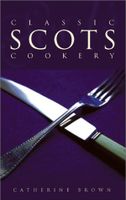Advertisement
Aberdeen Rowie (roll) or Butterie Golden
Appears in
Published 2003
Rustic, misshapen, crispy, salty and flaky, this is Scotland’s peasant version of the aristocratic French croissant. Rowies, like croissants, depend for their character on layers of fat – originally butcher’s dripping, though today’s are made with vegetable fat – between thin layers of yeast dough. They were made originally for fishermen at sea who needed a roll with a longer keeping quality. While it’s known in the North-East as a rowie, its national tag is butterie, though it has never contained butter. Its texture should be very crisp and flaky, though some bakers make a less crisp more ‘bready’ version which is not regarded by aficionados as a ‘real’ rowie. A ‘wee’ rowie is half-sized. Two stuck together with butter is a ‘double’ rowie. A bag of bities is a bag of broken rowies. A ‘cremated’ rowie is a well-fired rowie. The first literary mention of a ‘butterie’ is recorded in the Scottish National Dictionary in an account of an Arbroath Street seller (circa 1899). ‘Between butteries, Rob Roys (a kind of Bath Bun), an’ turnovers, her basket was weel filled.’


